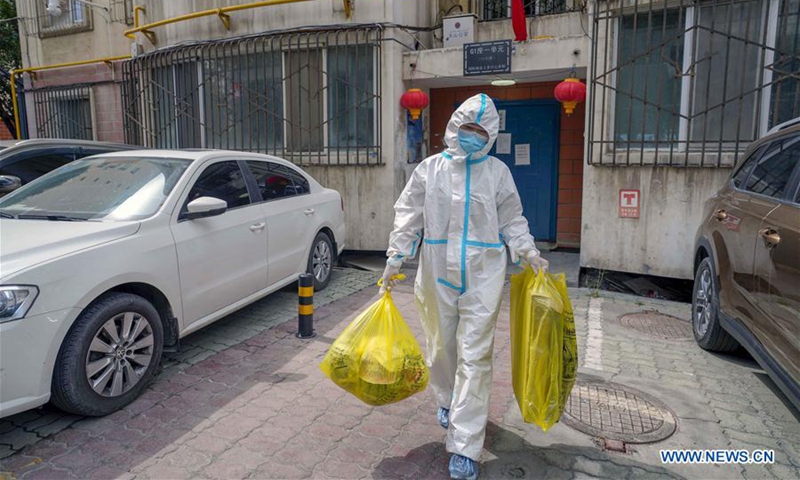Urumqi not letting down guard against COVID-19, despite downward trend in case numbers
By Liu Caiyu Source: Global Times Published: 2020/8/12 16:21:12

Qiu Tingting transports the collected garbage of the residents in quarantine at Renminlunan Community, Tianshan District of Urumqi, northwest China's Xinjiang Uygur Autonomous Region, Aug. 6, 2020. Qiu Tingting, 33, the secretary of the Renminlunan Community branch of the Communist Party of China, has been working tirelessly in the community during the COVID-19 epidemic. Residents in this community regard Qiu and her colleagues as "community servants at the frontline of epidemic prevention and control" for their careful and thoughtful work. (Xinhua/Zhao Ge)
Urumqi, the capital city of Xinjiang Uygur Autonomous Region, remains on high alert against COVID-19 and is giving repeated nucleic acid tests to people at high risk of infection, despite the number of cases in the city showing a downward trend.
On Tuesday the city saw nine confirmed patients, the first time the daily number had fallen to single digits in the latest outbreak.
It has been 28 days since July 17, when Urumqi decided to lock down communities and required residents to stay indoors, and the city shows no signs of easing restrictions. Hardly anyone can be seen walking on the streets except sanitation workers, police and security guards in front of communities, according to locals in Urumqi reached by the Global Times on Wednesday.
The Xinjiang health authority reported Wednesday that Urumqi logged nine confirmed cases and eight asymptomatic infections on Tuesday, the lowest daily number of confirmed infections since the clustered outbreak in early July.
As of Tuesday, Urumqi has reported a total of 531 confirmed cases. The current number of asymptomatic infections stands at 131, and 14,569 people are under quarantine.
The citywide free nucleic acid tests on all 3.5 million residents have been completed, but on that basis, Urumqi is giving repeated tests on key populations and communities where confirmed patients have been found, Zhang Yuexin, a medical expert who is part of the Xinjiang anti-epidemic group and a professor of the infectious disease department of the First Affiliated Hospital of Xinjiang Medical University, told the Global Times on Wednesday.
Residents in many key communities in Urumqi, such as those in Tianshan district and Sayibak district which are close to the clustered outbreak, were given at least five rounds of nucleic acid tests, the Global Times learned from locals.
"I just finished my fifth round of nucleic acid test today. Medical staff took samples one by one downstairs," a resident surnamed Liu told the Global Times. She said she doesn't know why so many rounds of tests are needed, as residents have all been staying at home since the recent outbreak began.
Li Pengxin, the anti-epidemic group leader in Xinjiang, earlier said that Urumqi completed two rounds of citywide testing last week. People in key communities, quarantine hotels and venues were tested three or four times. "By testing residents every five days, patients can be discovered to the maximum extent."
Zhang said the reason for the repeated tests is to find infected patients and patients who have no symptoms or those in their incubation period. "Repeated tests will ensure no one goes undetected. People carrying very little of the virus can be found through repeated tests. The novel coronavirus is cunning."
In Wuhan, at least half to two thirds of confirmed patients had shown symptoms of fever, coughs, muscular soreness and fatigue, but almost half of the confirmed patients in Urumqi had no symptoms at all, with only one fifth of them having fever and a few feeling fatigue, Qiu Haibo, deputy president of Zhongda Hospital at Southeast University in Nanjing, East China's Jiangsu Province, and also an expert from the medical treatment group sent to assist Xinjiang under the National Health Commission, told media Tuesday.
Qiu said those patients in Urumqi show very atypical symptoms, which is also reflected in their CT images. The number of silent virus carriers found in the early stages in Urumqi may be higher than any other city in China.
Silent carriers refer to those whose nucleic acid tests are positive but who show no clinical symptoms and no abnormality in their lung CT scans. To curb the spread of the virus, Urumqi has strengthened its efforts in finding silent carriers, and once found, they are put under medical observation, Zhang noted.
The daily testing capability in Urumqi is over 800,000 and testing centers have adopted the batch testing method, which mixes five samples in a single test, according to Urumqi government officials.
Some patients only tested positive in their third test, as not all infected people can be found at one time due to the sensitivity of the detection reagents, Wen Guoxin, the deputy director of Urumqi's disease prevention and control center, said Tuesday.
Repeated nucleic acid tests among close contacts - people related to the clustered outbreak, people who may be exposed and people who live in the same community as COVID-19 patients - are an important way of finding silent carriers, health authorities in Urumqi said.
Zhang told the Global Times that Urumqi treated silent carriers the same as confirmed patients. They are discharged from medical observation if they return negative results for three rounds of tests and their lung CT scans come back normal.
Confirmed cases and silent carriers continue to be reported in Urumqi, and overall it is showing a downward trend, but now is not the right time to let down its guard, Zhang said, adding that as it gets colder in the city, the virus spread may reappear, suggesting "only when zero confirmed cases are reported for a week would it be proper for the city to consider easing the restrictions."
Posted in: SOCIETY